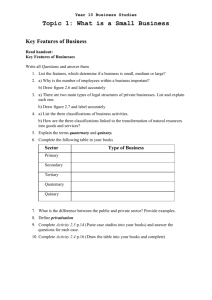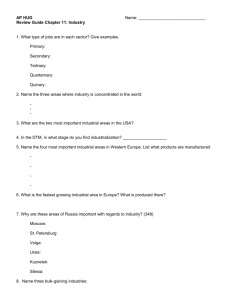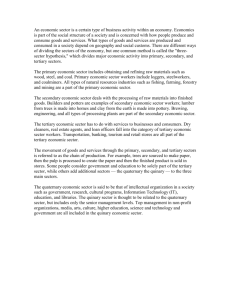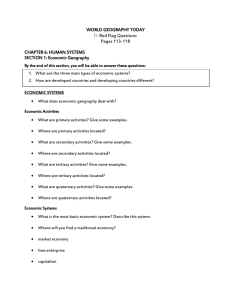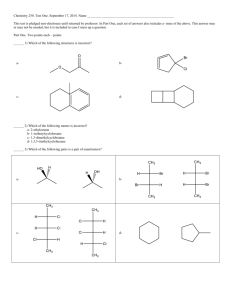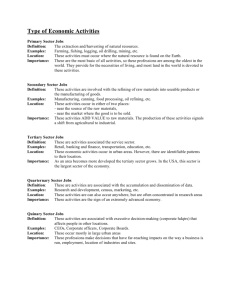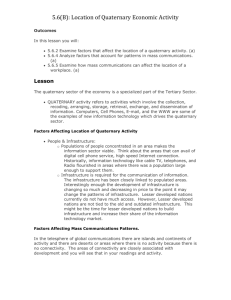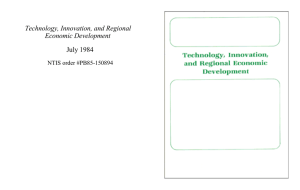chapter 27: deindustrialization and the rise of the service sector
advertisement
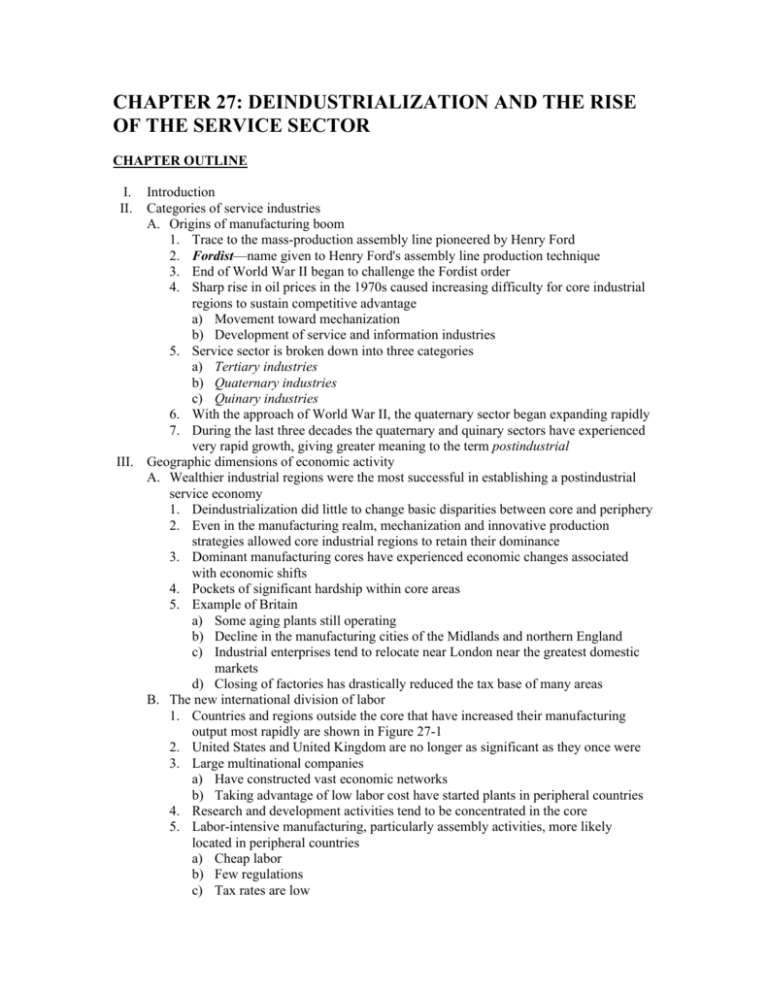
CHAPTER 27: DEINDUSTRIALIZATION AND THE RISE OF THE SERVICE SECTOR CHAPTER OUTLINE I. II. Introduction Categories of service industries A. Origins of manufacturing boom 1. Trace to the mass-production assembly line pioneered by Henry Ford 2. Fordist—name given to Henry Ford's assembly line production technique 3. End of World War II began to challenge the Fordist order 4. Sharp rise in oil prices in the 1970s caused increasing difficulty for core industrial regions to sustain competitive advantage a) Movement toward mechanization b) Development of service and information industries 5. Service sector is broken down into three categories a) Tertiary industries b) Quaternary industries c) Quinary industries 6. With the approach of World War II, the quaternary sector began expanding rapidly 7. During the last three decades the quaternary and quinary sectors have experienced very rapid growth, giving greater meaning to the term postindustrial III. Geographic dimensions of economic activity A. Wealthier industrial regions were the most successful in establishing a postindustrial service economy 1. Deindustrialization did little to change basic disparities between core and periphery 2. Even in the manufacturing realm, mechanization and innovative production strategies allowed core industrial regions to retain their dominance 3. Dominant manufacturing cores have experienced economic changes associated with economic shifts 4. Pockets of significant hardship within core areas 5. Example of Britain a) Some aging plants still operating b) Decline in the manufacturing cities of the Midlands and northern England c) Industrial enterprises tend to relocate near London near the greatest domestic markets d) Closing of factories has drastically reduced the tax base of many areas B. The new international division of labor 1. Countries and regions outside the core that have increased their manufacturing output most rapidly are shown in Figure 27-1 2. United States and United Kingdom are no longer as significant as they once were 3. Large multinational companies a) Have constructed vast economic networks b) Taking advantage of low labor cost have started plants in peripheral countries 4. Research and development activities tend to be concentrated in the core 5. Labor-intensive manufacturing, particularly assembly activities, more likely located in peripheral countries a) Cheap labor b) Few regulations c) Tax rates are low 6. Trade itself is a tertiary economic activity a) Patterns of trade vary by industry b) Dominant flow is among and between core countries, and newly industrializing countries c) Level of trade between peripheral countries is low 7. Production of television receivers provides an example of how changing multinational networks function 8. Discussion of foreign direct investment 9. Expansion of international banking 10. For many countries the cost of servicing their debts has exceeded revenues (Figure 29-2) C. A Sense of Scale box: Nike and Economic Globalization D. New influences on location 1. Service industries a) Many are not tied to raw materials or need large amounts of energy b) Market accessibility is more relevant 2. Discussion of why tertiary, quaternary, and quinary industries locate where they do E. Specialized patterns of economic concentration and interaction 1. World cities a) Have corporate structures and flows of capital that transcend national boundaries b) John Friedmann calls world cities the control centers of the world economy c) May not be the largest in terms of population d) Figure 29-3 shows their basic pattern of geographic location e) Discussion of Figure 29-3 2. Specialized economic zones a) Did not exist before the late twentieth century b) Special manufacturing export zones in poorer countries c) High-technology corridors in wealthier countries d) Such zones are often created in places with easy access to export markets e) By the early 2000s, more than 60 countries had established such zones f) High-technology corridors have sprung up in the global economic core (1) California's "Silicon Valley" (2) Called technopoles (3) Other examples and their locations are discussed g) The drawbacks of high-technology industries F. Looking Ahead box: The Future of Tourism G. A service industry giant: tourism 1. Distinctive geographic nature 2. Accounts for some 11 percent of all jobs worldwide 3. Began as incomes and leisure time increased for a rapidly expanding segment of the population 4. Cruising is one of its fastest-growing segments 5. Tourism has transformed many landscapes around the world 6. Theme parks 7. In 2000, the economic value of goods and services exceeded $4 trillion IV. Time-space compression and its impact A. Set of developments that have changed the way we think about time and space in the global economic arena 1. Offshoot of concept of time-space convergence—reduction in the importance of distance 2. Technological developments have made possible faster transportation and communication across significant distances 3. Transition away from a Fordist industrial system to a more flexible set of production practices 4. Places have been brought closer together in time and space 5. Rise of the World Wide Web 6. Geographical distribution of people with access to network connections closely mirrors map of "haves" and "have-nots" (Figure 29-4) B. Discussion of a shrinking world
